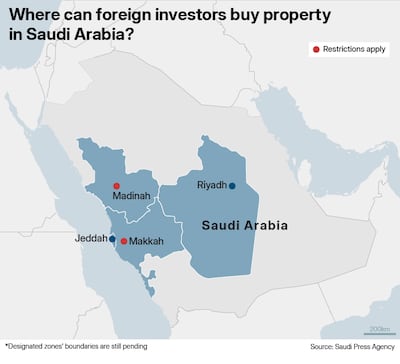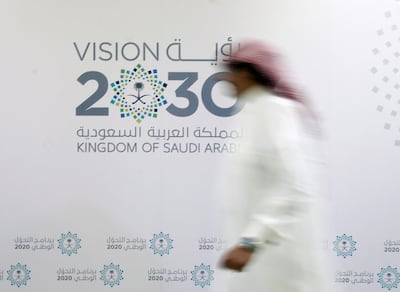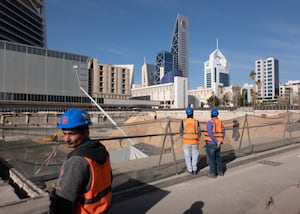Global investors are now sizing up the profit returns from Saudi Arabia's real estate market, as the kingdom's once closed-off sector will soon be accessible. Interest has peaked, especially as opportunities to buy into megaprojects such as Neom's The Line, Oxagon and Diriyah are expected.
On July 8, the Saudi cabinet approved the Law of Real Estate Ownership and Investment by Non-Saudis, replacing a framework from 2000 and formally opening designated zones across the kingdom, including Riyadh and Jeddah, to foreign ownership from January 2026.
This sweeping reform aligns with the kingdom's Vision 2030 target to diversify the economy, boost foreign direct investment and expand real estate supply, while protecting sovereign interests through controlled zone designations.
Foreign investors are probably asking what type of return on investment they could receive given the kingdom's activity, and the potential is promising.
How ready is the market?
Following publication in the official gazette, the Real Estate General Authority must publish implementing regulations on the Istitlaa platform within 180 days. It has time to define zones open to foreign buyers and prescribe approval processes.
The Ministry of Investment will streamline foreign investment approvals and the Ministry of Interior will integrate land-registry data with security protocols. Together, these institutions must co-ordinate licensing, title registration and compliance checks to launch transactional platforms by the start of 2026.
Saudi Arabia’s government has demonstrated capacity for rapid digital roll-outs, exemplified by e-government portals and integrated identity systems, suggesting core registry upgrades can be delivered on schedule.

Moreover, existing permissions already enabled foreign citizens to invest indirectly – for example, through Premium Residency, licensed developers, or real estate funds – creating precedents for a more structured regime, but the main hurdles could involve:
- Regulatory consultation, by compressing public comment cycles to meet the 180-day deadline.
- IT integration, by updating national land registries to handle new ownership categories and cross-border title verification.
- A financing ecosystem, which would need to be adapted, especially the mortgage frameworks for foreign buyers that will include risk and compliance protocols.
With Vision 2030’s political backing, a January 2026 activation is credible. Advancing to an April 2026 operational window will depend on top-level prioritisation of the law and dedicated interministerial task forces.
Global market comparison
This move by Saudi Arabia feels very much like Dubai did back in 2002, when it opened certain areas for foreign ownership.
With the reforms of the country also making headlines, now would be a great time for any investor to get in early and benefit from capital appreciation of real estate as the market opens further.
All of this will of course take time, as Dubai has shown, the period needed for the real estate market to lead to maturity takes time. Notwithstanding this, I think Saudi Arabia and its investors are in a great position to benefit from this move going forward.
Global investors with their eyes on Saudi Arabia must consider local returns against Gulf and global benchmarks.
In the fourth quarter of 2024, Saudi Arabia’s real estate price index rose 3.6 per cent year-on-year, led by a 10.2 per cent price surge in Riyadh and 4.6 per cent in Najran.
Meanwhile, rental markets remain strong. Riyadh yields average 8.89 per cent and Jeddah 7.89 per cent gross annually.
If we were to compare Saudi Arabia with the UAE, the US and the UK, Dubai delivers rental yields between 5 per cent and 11 per cent, buoyed by robust demand in mixed-use and luxury segments and the golden visa programme.
The US’s average gross rental yield is 6.68 per cent as of the second quarter of 2025, with high-yield cities such as Detroit exceeding 20 per cent. The UK average buy-to-let gross yield stands at 5.60 per cent, with cities including Sunderland and Aberdeen offering yields above 8 per cent.
Saudi Arabia’s combination of double-digit yields and mid-single-digit price appreciation positions it competitively within the Gulf and many western markets.
More needed
Real estate market maturity marked by liquidity, transparency and global investor confidence will take time as has been shown in the UAE, but as long as Saudi Arabia build the below, it should be well on its way to maturity in the years to come.

Secondary market depth will be needed by launching real estate investment trusts and collective investment schemes to deepen capital pools and improve liquidity.
Valuation standards will need to be upgraded by establishing independent appraisal bodies and aligning with IFRS 13 for fair-value reporting.
Legal and dispute resolution will also require upgrading, by expanding specialised real estate courts and arbitration centres to protect investor rights.
Financing and securitisation will need to be more competitive by developing covered-bond and mortgage-securitisation markets to diversify funding and lower borrowing costs.
These enhancements, while not prerequisites for the January 2026 opening, will be essential for evolving from a frontier to a mature market akin to the UK and US over several years.
The opening of Saudi Arabia’s real estate market is one of the most consequential investment gateways in the region since the UAE did the same more than 20 years ago.
Regulatory foundations appear on track for January 2026, with an April 2026 operational window possible, if expedited.
Early market metrics, robust price growth and high rental yields will underscore strong growth potential. But full maturation will depend on continued reforms in liquidity, transparency and financing infrastructure.
For global investors, Saudi Arabia offers frontier-market yields with the promise of a reliable long-term destination as institutional frameworks deepen under the Vision 2030 initiative.




